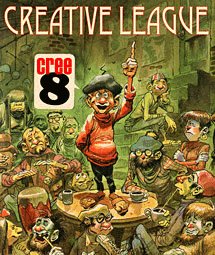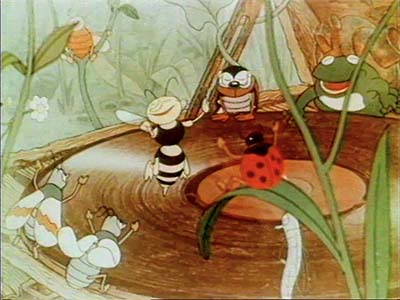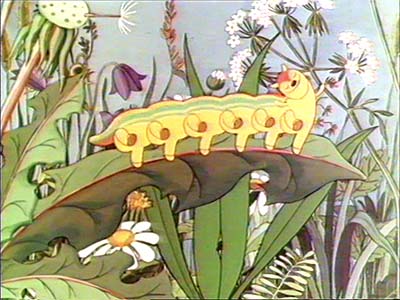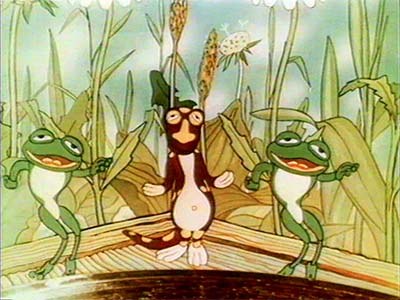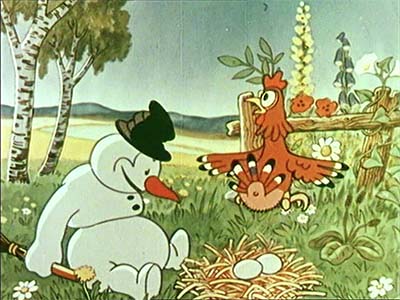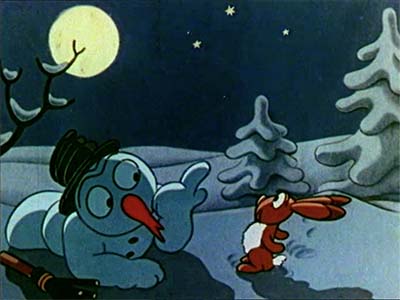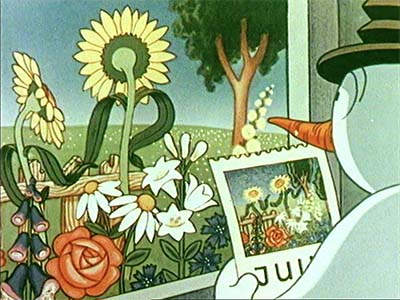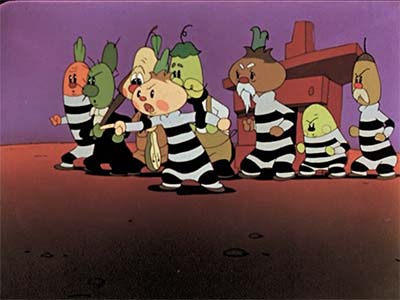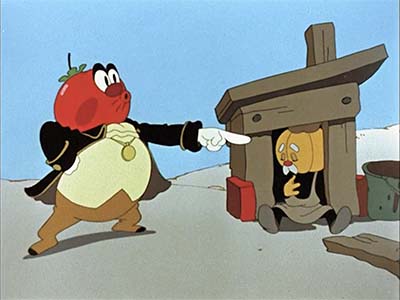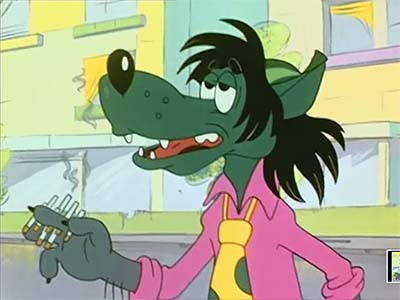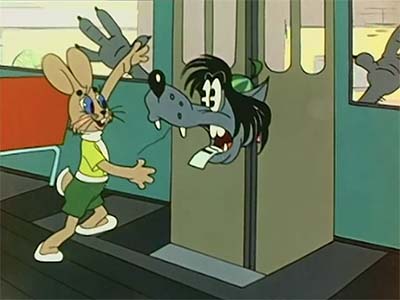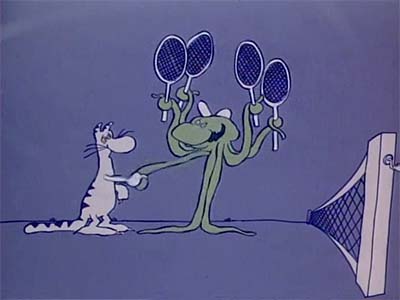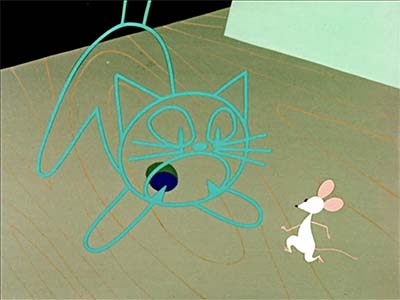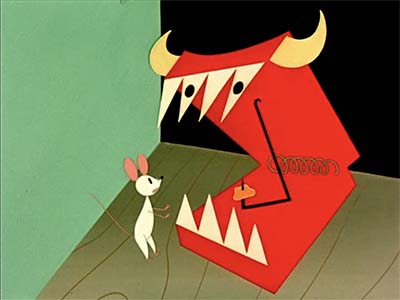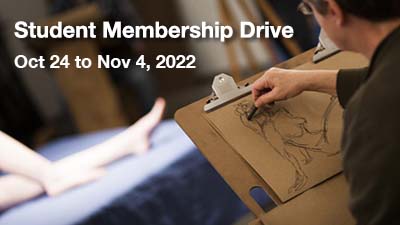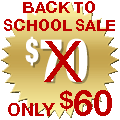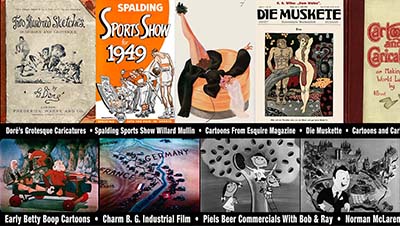People who aren’t members of Animation Resources don’t understand how comprehensive our Reference Packs are. Over the next couple of weeks, we will be posting what each section of our current RefPack looks like. If you are a member of Animation Resources, click on this post to go to the Members Only page. If you aren’t a member yet, today is the perfect time to join! Our current Reference Pack is one of our best yet, and General and Student Members get access to a special Bonus Archive with even more material from past Reference Packs.
What are you waiting for?![]()
JOIN TODAY!
https://animationresources.org/membership/levels/

The world of animation is much bigger than it might appear to us at first glance. We are all familiar with the films we grew up with, but Hollywood wasn’t the only place that produced great cartoons… Poland, Japan, Russia, China and Europe all have their own traditions and a rich history of animated film making. Animation Resources’ archive contains many foreign films that are rarely seen in the United States. We feature a sampling of interesting animation from around the world in each Reference Pack.
Two Fischerkoesen Shorts
![]()
Hans Fischerkoesen: Weathered Melody 1943 / The Snowman 1944 (Germany)
Download this article
Hans Fischerkoesen was often referred to as “the Walt Disney of Germany”, but truth be told, his talent wasn’t for long form storytelling animation, but rather cartoon advertising shorts. His advertising career began in 1921, and until his death in the early 1970s, he produced over a thousand animated commercials, most of which are lost.
He was born in Saxony in 1896, and being a sickly child, his parents spoiled him. He spent a great deal of time drawing and creating puppet shows with his sister Leni. His asthma prevented him from being drafted for the front lines during WWI, but he did work in army hospitals, where he witnessed the suffering of soldiers with horrible injuries. In 1916, he and his sister enrolled in the Academy of Graphic Arts in Leipzig, and he began work on a film titled The Hole In The West which criticized war profiteers.
In 1921, flush with money from the sale of The Hole In The West, Fischerkoesen began producing animated advertisements, which screened in local theaters. The success of his concept was immediate, and it led to a contract with the Pinschewer Advertising Company. By 1931, he was featured in a Leipzig newspaper under the headline, ” Watch Out Mickey Mouse and Felix The Cat”. His advertising business expanded to include military training films and animated segments in feature films, but his success came to an abrupt halt with the rise of the Nazi Party in Germany.
Many of the products his films had advertised were luxury items, which were banned from being advertised under the Nazis. By 1940, his business had diminished to a trickle. However both Hitler and Gobbels had an interest in the films of Walt Disney and aspired to create similar films in Germany. The Nazis established the Deutsche Zeichentrickfilme studio, which trained young cartoonists with the goal of creating an animated feature. With few other options, Fischerkoesen moved his studio to Potsdam, near the Nazi’s UFA Studios.
Because his experience was in very short form commercials, not longer form storytelling films, Goebbels partnered Fischerkoesen with a newspaper cartoonist named Horst von Mollendorf, who was responsible for writing the scripts for the proposed slate of animated films. The studio was ordered to produce films that were technically the equal of those of the Disney Studios. The orders were backed by ample funding, and Fischerkoesen went to work on three animated films that would introduce the German animation industry to the world. In order to cross cultural lines and increase the distribution for the films, they were made without dialogue. No subtitles would be needed.
The three films produced during the war years were “Weather Beaten Melody”, “The Snow Man” and “The Silly Goose”. The first of these films incorporated Jazz music, which was not favored by the Nazis, and “The Snow Man” acknowledges that times were difficult and people looked forward to a better future. But the third film made up for these transgressions by incorporating anti-Semitic symbolism, casting the fox in the story as a Jew. Goebbels was satisfied with the films.
When the war ended, Fischerkoesen was arrested as a Nazi collaborator, and thrown in the Sachsenhausen concentration camp by the Russian army. He was a model prisoner and eventually convinced his Russian captors that he was a part of an underground organization of artists that worked to undermine the Nazis. When he was released, he fled from the Soviet controlled area of Germany to the district overseen by France. Here he established the Fischerkoesen Studios, returning to the production of animated commercials. The studio was hugely successful throughout the 1950s.
The influence of television on the advertising industry in the early 60s led to shorter and snappier commercials, and Fischerkoesen found it difficult to keep up with the times. His studio closed briefly in 1972, returning under the supervision of his son shortly after Hans’ death.
In this RefPack, we are sharing “Weather Beaten Melody” and “The Snow Man”. The first film makes brilliant use of the multiplane camera setup, incorporating as many as 12 layers of grass and flowers surrounding the bee, who is the main character. “The Snow Man” opens with another incredible three dimensional view of snowflakes falling on a village. The snow falls upon the Snow Man, forming the shape of a heart. Audiences at the time certainly would have connected the shape of the heart on the Snow Man’s chest with the yellow stars of David Jews were forced to wear in public. This touch of humanity introduces a subtle element of protest to the film, as does the parable of the Snow Man dreaming of a better place to live, but having to give up his life to experience it for a moment.
We will share more of Fischerkoesen’s animation in future RefPacks.
MP4 Video File / SD / 8:55 / 553 MB Download
MP4 Video File / SD / 12:04 / 553 MB Download
SD VIDEO:
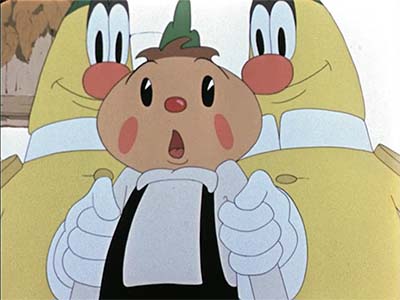
Cipollino: The Onion Boy
![]()
Boris Dyozhkin / Soyuzmultfilm, Russia / 1961
The story of Cipollino, the Onion Boy began as a fairy tale in an Italian children’s magazine. Set in a world populated by anthropomorphic fruits and vegetables, Cipollino fought Prince Lemon and Lord Tomato to free the townsfolk from oppression. After accidentally stepping on Prince Lemon’s foot, Cipollino becomes a wanted criminal. His father, Old Chipalone, claims that he himself stepped on the Prince’s foot to save Cipollino from punishment and is immediately jailed.
Cipollino rallies his friends to save the old man from his captors. The theme of an underclass rebelling against oppressive rulers appealed to Soviet readers, and in 1961, an animated film based on the tale was produced by Soyuzmultfilm. The cartoon was scored by the famous composer Karen Katchaturian, and it was so successful, in 1974 the music was adapted to a ballet.
Boris Dyozhkin, the director of Cippolino, was one of the most respected and prolific animators in Russia. In the 1930s, he broke with other Soviet artists who rejected the Western style, studying Fleischer and Disney films frame by frame to break down the techniques being used. His study led him to an unique understanding of the synchronization of rhythm between music and motion, which made him one of the most sought after timing directors at the studio. During WWII, he was staying at the home of fellow animator Roman Davydov when the Nazis bombed the area from the air. He threw himself over his wife to protect her from the blast, saving her life, but he lost his left eye to a shell fragment.
Dyozhkin is best known for a series of comedy shorts based on teams competing in various sports— hockey, skiing, boxing, etc. Cipollino is his only feature film. As you watch this, notice the wonderful rhythmic walk cycles and dynamic posing. He really gets the most out of the simple character designs by focusing on strong line of action, clear silhouettes and big contrasts. It’s a very appealing style of animation that seems much more modern than its six decade age.
MP4 Video File / SD / 37:41 / 713 MB Download
SD VIDEO:
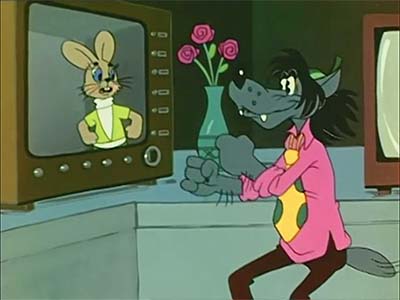
Well, Just You Wait Ep.05
![]()
Vyacheslav Kotyonochkin / Soyuzmultfilm, Russia / 1972
We continue the Russian Wolf and Rabbit cartoons with episode 05, “City Streets: Metro”.
The premise of Nu, Pogodi! (which translates into English as Well, Just You Wait!) was pitched by a writing team of satirical humorists to many directors at Soyuzmultfilm, but was rejected every time. Finally in 1969, Gennady Sokolsky agreed to direct a 2 1/2 minute pilot for the series in an omnibus film called “Happy Merry Go Round”. The general consensus at the studio was that the cartoon was “low class” and beneath the dignity of Soyuzmultfilm, but director Vyacheslav Kotyonochkin strongly believed in the concept, so the studio decided to take a chance and allow him to direct a few episodes… and then a few more… and then more.
Kotyonochkin was proven correct. The cartoons were a huge success. Between 1969 and 2006, Soyuzmultfilm ended up making 22 episodes, and in a 2014 poll of audiences all over Russia, Well, Just You Wait! was voted the most popular cartoon series of all time by a landslide. Although the series resembles both Tom & Jerry and the Roadrunner and Coyote series, the director, Kotyonochkin claimed not to have ever seen any of these Hollywood cartoons until 1987 when his son got a video tape recorder and Western tapes began to be imported.
In these Russian cartoons, there’s almost no dialogue, and the action almost always occurs on screen. Static tableaux are rare, as are detailed backgrounds and “on model” drawings. These cartoons focus on expressive poses and movement, and save time and expense by avoiding the careful cleanup required for character model details and overlapping action. The theory here is, if it moves funny, it’s funny… and they are right about that.
Shamus Culhane once lamented that television animation consisted of mostly lip-sync animation. He would have preferred to do away with lip-sync entirely and just have simple drawings that really move. Well, Just You Wait proves that he was correct.
We will have more Wolf and Rabbit cartoons in upcoming Reference Packs.
MP4 Video File / SD / 09:17 / 143 MB Download
SD VIDEO:
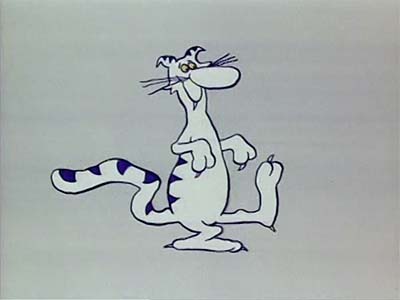
Six Maxi Cat Mini Cartoons
![]()
Zlatko Grgic / Zagreb Films, Croatia / 1971
In the early 1950s, an American film called The Four Poster was screened in Yugoslavia, now known as Croatia. (See RefPack047 for a copy of this important film.) It wasn’t a particularly successful as a movie, but it included animated sequences by John Hubley at UPA. (See download link below.) Animator Dusan Vukotik had read an article on UPA in Graphis magazine, and along with Vatroslav Mimica, he decided to create animated films in that style. With such a small sample of UPA’s work to inspire them, they interpolated their own theories of stylization and motion, creating an unique style that came to be known as the “Zagreb School”. The antithesis of Disney style, Zagreb films were adult, stylized, cynical and ironic, focusing on how “the little guy” is manipulated by forces beyond his control.
The animator and director of these mini-cartoons was Zlatko Grgic, a Croatian animator who later emigrated to Canada to join the Canadian Film Board. Grgic is best known for his series of cartoons featuring the character Professor Balthazar, an old man who solves problems for his friends by creating inventions with a magical machine. Produced between 1967 and 1973, the series ran all over the world. Its silent pantomime translated easily to various cultures. It aired in the United States on Chuck Jones’ television program, Curiosity Shop. We will have examples of this imaginative series in an upcoming RefPack.
But this time, we’re featuring Grgic’s series of one minute shorts featuring the character, Maxi Cat. 24 mini-cartoons were made based on a simple premise or prop. They play off a simple sequence of gags building to a topper gag. There is no attempt at telling a story or conveying complex personality— just fun.
When students study animation in school, they are asked to make a short film. Too often they get swept up in trying to tell a story and bite off more than they can chew. As the deadline approaches, the job goes from experimenting and learning to just cranking out scenes to fill the planned running time. If you really want to learn to animate, you would do better to follow this model of simple one minute cartoons. Set a theme for each one… lip sync, walks that express attitude, four legged vs two legged runs, an argument between two characters… just keep it simple and under a minute. You’ll learn a lot more from doing a handful of short study films than you will by making a ten minute student film.
MP4 Video File / SD / 3:04 / 47 MB Download
MP4 Video File / SD / 2:54 / 36 MB Download
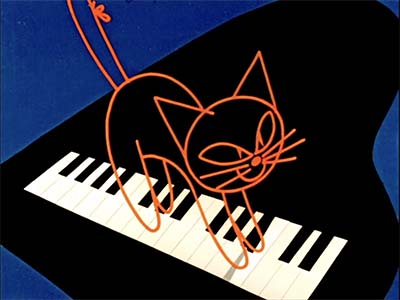
Cat And Mouse
![]()
Wladyslaw Nehrebecki / Bielsko Biala Studio, Poland / 1958
Now we shift from Croatia to Poland. Wladyslaw Nehrebecki was best known for a series of cartoons titled Bolek and Lolek, which were the adventures of two boys who were based on Nehrebecki’s sons. Today we are sharing a film that is unique among Nehrebecki’s work… “Cat And Mouse”.
Clearly influenced by the films of UPA, “Cat And Mouse” skillfully juggles three of the fundamental elements of artistic rendering— line, shape and form. The simple flat colors and shapes don’t move flat like modern Flash cartoons. The camera moves around them at times in perspective, creating a feeling of space. With more detailed and elaborate designs, animating in perspective would be extremely difficult, but with flat shapes, the animator is able to visualize them easier.
The color in this cartoon is very expressive and there are a lot of fourth dimensional gags where one dimensional lines move alongside two dimensional flat shapes of color in three dimensional ways. This combines to create the best kind of cartoon magic. I hope this cartoon gives you ideas how your own animation can be more graphic and less literal.
MP4 Video File / SD / 8:32 / 137 MB Download
More members mean we can bring you more special downloads.
JOIN TODAY To Access Members Only Content
Animation Resources is one of the best kept secrets in the world of cartooning. Every month, we sponsor a program of interest to artists, and every other month, we share a book and up to an hour of rare animation with our members. If you are a creative person interested in the fields of animation, cartooning or illustration, you should be a member of Animation Resources!
It’s easy to join Animation Resources. Just click on this link and you can sign up right now online…
JOIN TODAY!
https://animationresources.org/membership/levels/
![]()
![]() Animation Resources depends on your contributions to support its projects. Even if you can’t afford to join our group right now, please click the button below to donate whatever you can afford using PayPal.
Animation Resources depends on your contributions to support its projects. Even if you can’t afford to join our group right now, please click the button below to donate whatever you can afford using PayPal.





